TL;DR
Quick fix for an awkward living room layout: rotate into an L-shape, keep 30–36 inches of walking space, and downsize to a round or nesting coffee table. Mount or move the TV to the accent wall at eye level, or keep one sofa and add two lighter armchairs. Test it first with an AI tool to visualize furniture layout in your actual photo at ReimagineHome.ai. This avoids returns, fits maximalist/boho style, and works with tight budgets and pets.
Why This Room Feels ‘Off’ (and Why You’re Not Imagining It)

L-shaped sofa layout creates flow, improving space and viewing experience without clutter.
Most designers recommend at least 30–36 inches of clear walking space and roughly 14–18 inches between sofa and coffee table; right now, your room doesn’t have it. The solution is to rotate into an L-shape, reduce the coffee table footprint, and position the TV where glare is lowest—often the accent wall—so the seating serves both conversation and viewing.
- Layout first: switch two facing sofas to an L-shaped arrangement to create flow and reduce the “waiting room” feel.
- TV placement: mount on the accent wall at eye level, or choose a wider, lower media console that visually grounds the wall.
- Table sizing: swap to a narrower, oval/round or nesting coffee table; aim for 14–18 inches from sofa front.
- Circulation: preserve 30–36 inches in main paths; 24 inches minimum where space is tight.
- Seating mix: if still cramped, keep one sofa and add two lighter armchairs instead of the second sofa.
- Rug: scale so front legs of seating sit on it without forcing the room into a bottleneck.
- Maximalist/boho layering: art, pillows, and a statement ceiling light shift focus upward and integrate the sofas.
- See it first: visualize these changes on your actual room photo with AI.
Before you move a single sofa or pick up a paint roller, upload a photo to ReimagineHome.ai and test a few ideas safely.
See how AI helps with small-space layouts • Read more on AI-powered furniture planning • Beginner’s guide to virtual room design tools
Why Interior Design Dilemmas Are Usually About Layout, Scale, and One Wrong Piece
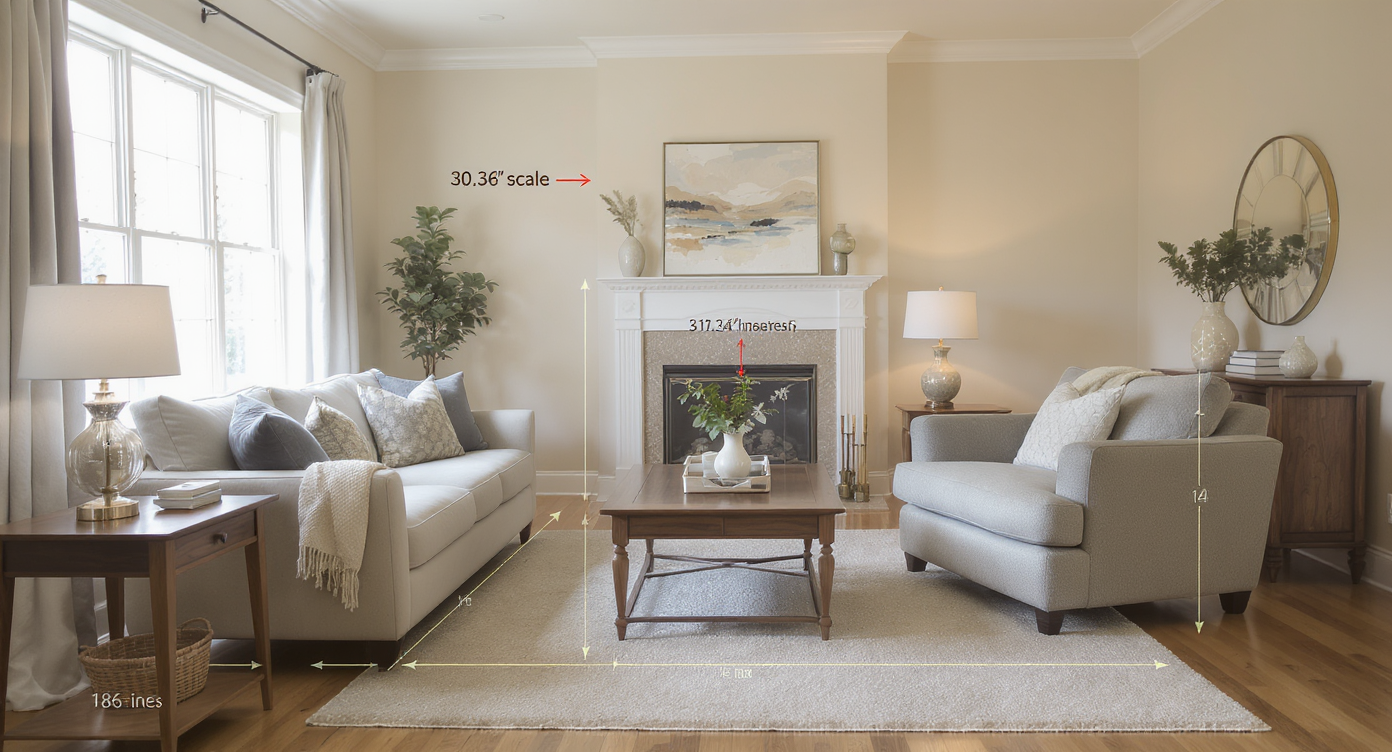
Layout, scale, and one mismatched piece often create common interior design dilemmas in living rooms.
Most living rooms feel calmest when main walkways hold 30–36 inches of clearance, so knees and shins aren’t dodging furniture. Two deep sofas facing each other compress that corridor and create a “standoff,” especially with a wide, rectangular coffee table in the middle. The dominant pain point here isn’t the sofa style; it’s the depth and the opposing placement.
Rotate into an L. One sofa along the window and the other perpendicular on the adjacent wall usually restores circulation, lets the coffee table float in front of a single seat, and reduces glare on the TV. If your window wall is non‑negotiable, put the TV on the painted wall and mount it just low enough to meet eye level from the seated position. A longer, lower media unit can visually widen a tight room and absorb that “too much sofa” sensation.
Often, one misfit piece is the real culprit. In this case, the coffee table reads heavy and overly wide, exaggerating how close the sofas sit. Swap to round, oval, or nested pieces and immediately gain inches and softer sightlines. If clearances are still tight or the arm of one sofa blocks the other, replace one sofa with two slim armchairs; you’ll keep seating capacity while regaining air and movement.
Anecdote
That corner where the armrest blocks the other sofa’s seat? I’ve seen couples quietly negotiate the “good seat” for months. After swapping to an L with nesting tables, they could finally walk through without the shin‑bruise shuffle—and still host game night.
Furniture Rules That Quietly Solve Most Room Problems
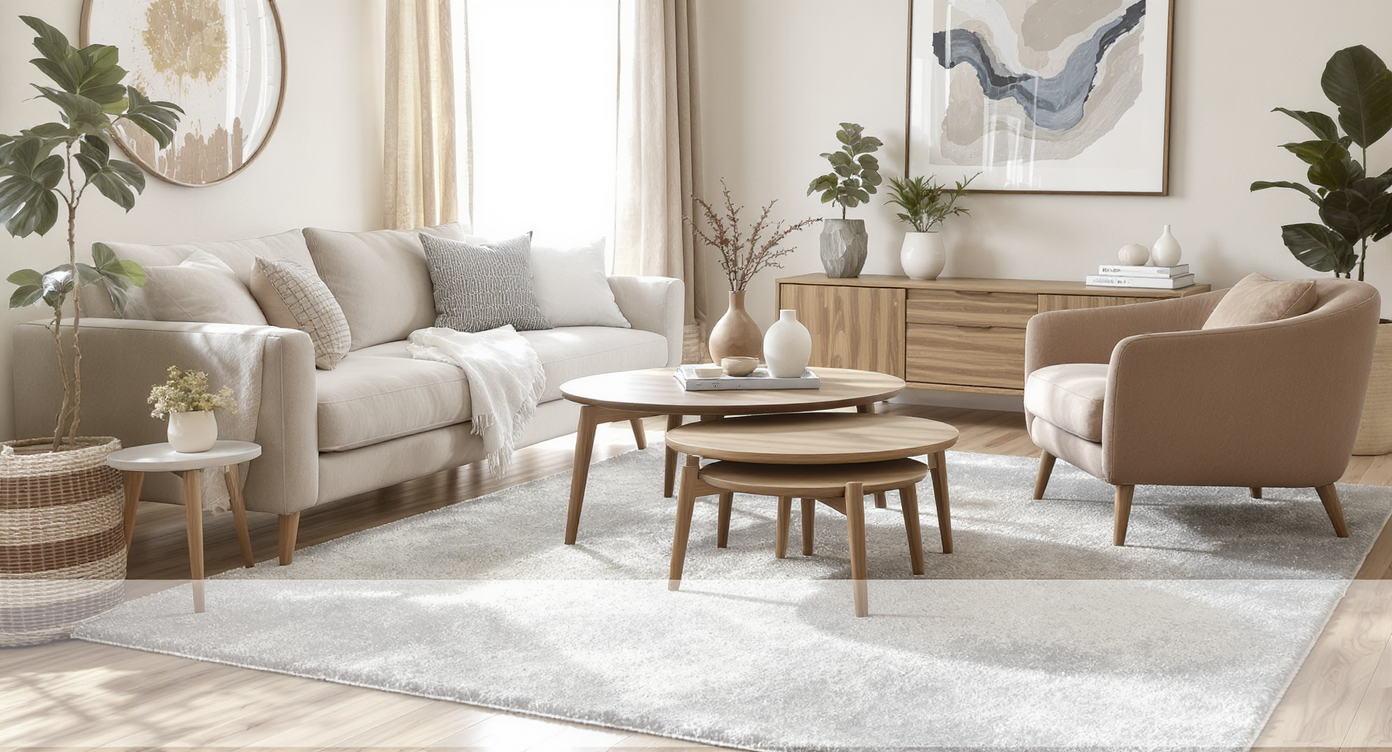
Applying furniture spacing rules creates room flow and comfortable, functional seating zones.
Coffee tables work best 14–18 inches from the sofa edge so legs can slide in comfortably without feeling trapped. That single rule, plus a 30–36 inch path, will correct most everyday living room layouts.
- Sofa depth: 36 inches feels plush but can overwhelm small rooms; consider one deep sofa plus lighter chairs rather than two deep sofas.
- Facing sofas: allow 36–48 inches between fronts for easy pass‑through. If you can’t get that, abandon the face‑off.
- Rugs: aim for front sofa/chair legs on the rug; leave 6–12 inches of floor exposure around the rug’s perimeter for breathing room.
- TV height: center of screen roughly at seated eye level (about 40–44 inches from floor for many setups). Viewing distance often feels good at 1.5–2.5× screen diagonal.
- Tables: swap a single large rectangle for two nesting rounds or a petite oval. Side tables plus a small, mobile ottoman can replace a bulky coffee table entirely.
Use these numbers inside ReimagineHome.ai to test clearances visually with your real walls, windows, and rug. It’s the fastest way to confirm whether an L‑shape, one‑sofa‑two‑chairs, or a slimmer table solves the squeeze.
How ReimagineHome.ai Helps You Test Layouts, Styles, and DIY Ideas
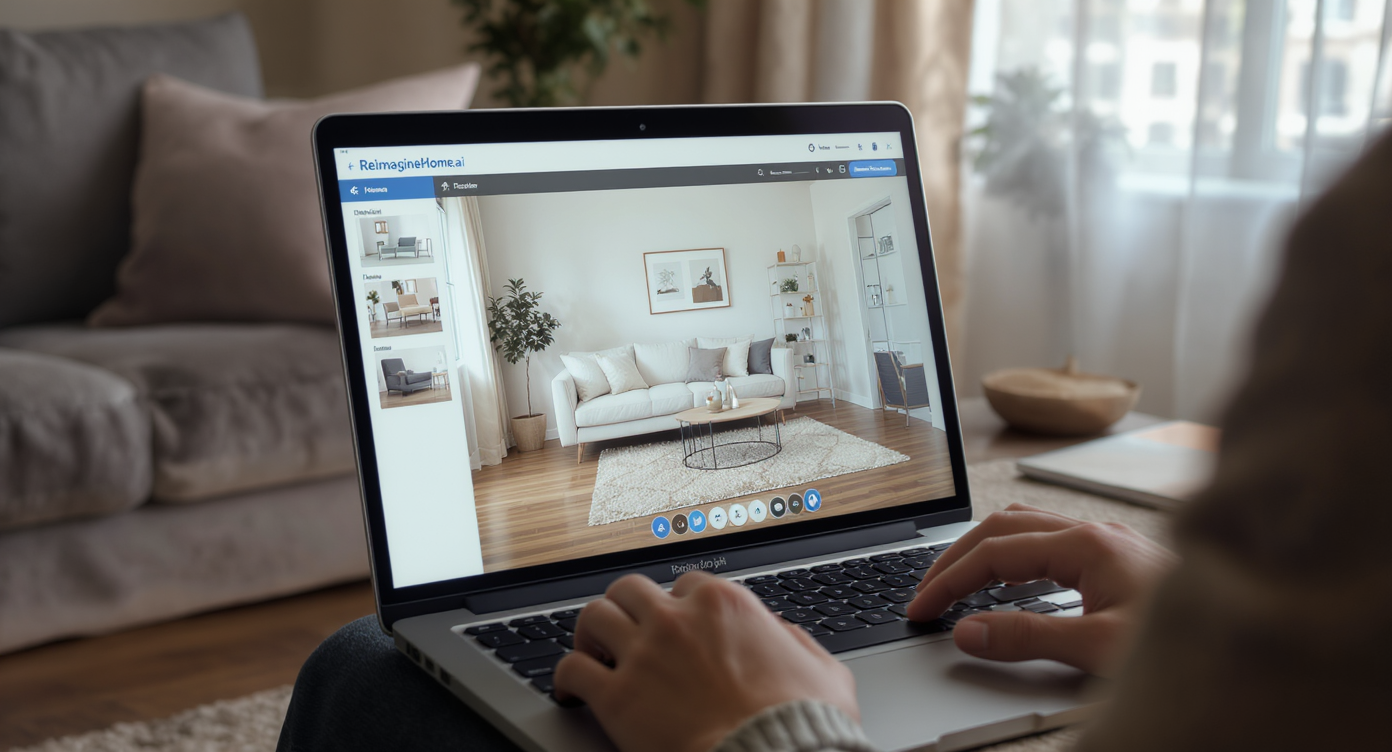
ReimagineHome.ai lets you test furniture layouts and styles virtually before making changes physically.
AI tools can show multiple layout and style options in minutes, before you move a single piece. With ReimagineHome.ai, you can restyle your room from one photo—no measurements—then quickly iterate through L‑shapes, chair swaps, and TV wall moves.
Start by uploading a photo of your current setup. Use the AI restyle to preview boho/maximalist direction: layered pillows, woven pendants, rattan accents, and a gallery wall above the sofa. Then try an AI layout exploration: place one sofa on the window wall, rotate the second to form an L, and test a small round coffee table vs. nesting tables. You can also audition paint color shifts, from deep terracotta to olive, and see how a lower, wider media console anchors the space.
If you’re browsing best AI interior design tools 2025 or virtual room design tools for beginners, ReimagineHome.ai stands out for quick, realistic room transformations from a single photo. It’s also helpful for small spaces, free vs. paid exploration, and testing furniture layout online—especially when you’re unsure whether to keep both sofas or trade one for armchairs.
Step-by-Step: Fixing This Room Using AI and Simple DIY Changes

Step-by-step fixes using AI and simple DIY swaps improve flow and comfort in small living rooms.
Aim for 30–36 inches of open path from entry to seating; if you don’t have it, the sofa or coffee table is too deep or too close.
- Photograph your room and upload it to ReimagineHome.ai.
- Generate two scenarios: (A) L‑shape with both sofas; (B) one sofa + two armchairs. Compare clearances and sightlines to the TV.
- Move the TV to the accent wall in the render. Check glare and mount height; target the screen center near seated eye level.
- Swap the coffee table for an oval/round 30–36 inches wide, or a pair of 18–22 inch nesting tables. Keep 14–18 inches to the sofa.
- Adjust the rug: ensure front legs of seating sit on it without forcing the walkway below 24 inches. If the rug is driving congestion, size down or rotate.
- Style the verticals: add a statement ceiling fixture and a gallery wall to pull the eye up—key for maximalist/boho rooms.
- Pet‑friendly layering: replace blankets with washable, textured throws and patterned pillows that disguise fur; consider a performance‑fabric seat cover.
- Physical test: tape the new table footprint on the floor; if your path isn’t 30 inches at minimum, choose smaller.
- Commit in phases: mount the TV and swap the table first; then reassess whether the second sofa or two armchairs serve you better.
Visualization Scenario
Upload a photo, ask ReimagineHome.ai to restyle “boho maximalist with L‑shaped seating.” Compare renders with round vs. nesting tables, TV on the accent wall vs. window wall, and one‑sofa‑two‑chairs. Keep the option that preserves a 30–36 inch path and puts the TV at eye level.
FAQ
How do I fix an awkward living room layout without buying all new furniture?
Rotate into an L‑shape, mount or move the TV to reduce glare, and switch to a smaller round or nesting coffee table while keeping 30–36 inch walkways. Visualize it first with ReimagineHome.ai to avoid heavy lifting.
Which AI interior design tool is best for small apartments?
For quick, realistic restyles from one photo and easy layout tests, ReimagineHome.ai is a strong pick among the best AI interior design tools 2025, especially for small spaces and rental‑friendly planning.
How can I see if a new sofa or rug will fit my room before I buy it?
Upload a photo and preview furniture layout online to check clearances, sofa depth, and rug edges. Aim for 14–18 inches from sofa to table and 30–36 inches in main paths.
Can I use AI tools to plan DIY furniture or paint projects?
Yes—test paint colors, gallery walls, lighting, and DIY furniture finishes virtually. It’s a low‑risk way to confirm style and scale before drilling or painting.
What’s the easiest way to mix different furniture styles in one room?
Follow a 70/30 rule (one dominant style, one accent style), repeat materials or colors 3 times, and add curves to balance boxy pieces. Preview combinations in AI first.
Visualize Your Room’s Next Chapter
Small rooms don’t fail because they’re small; they fail when scale and circulation get ignored. With a few measurable moves—an L‑shape, a slimmer or round table, a better TV wall—you’ll get a cozy, conversation‑first layout that still works for movie nights and board‑game marathons. Maximalist/boho layering will do the rest, turning “too prominent” into “perfectly grounded.”
When you can see the possibilities, it’s easier to move with confidence. Start by uploading one honest photo to ReimagineHome.ai and let your next version of the room come into focus.
.svg)

.svg)
.jpg)
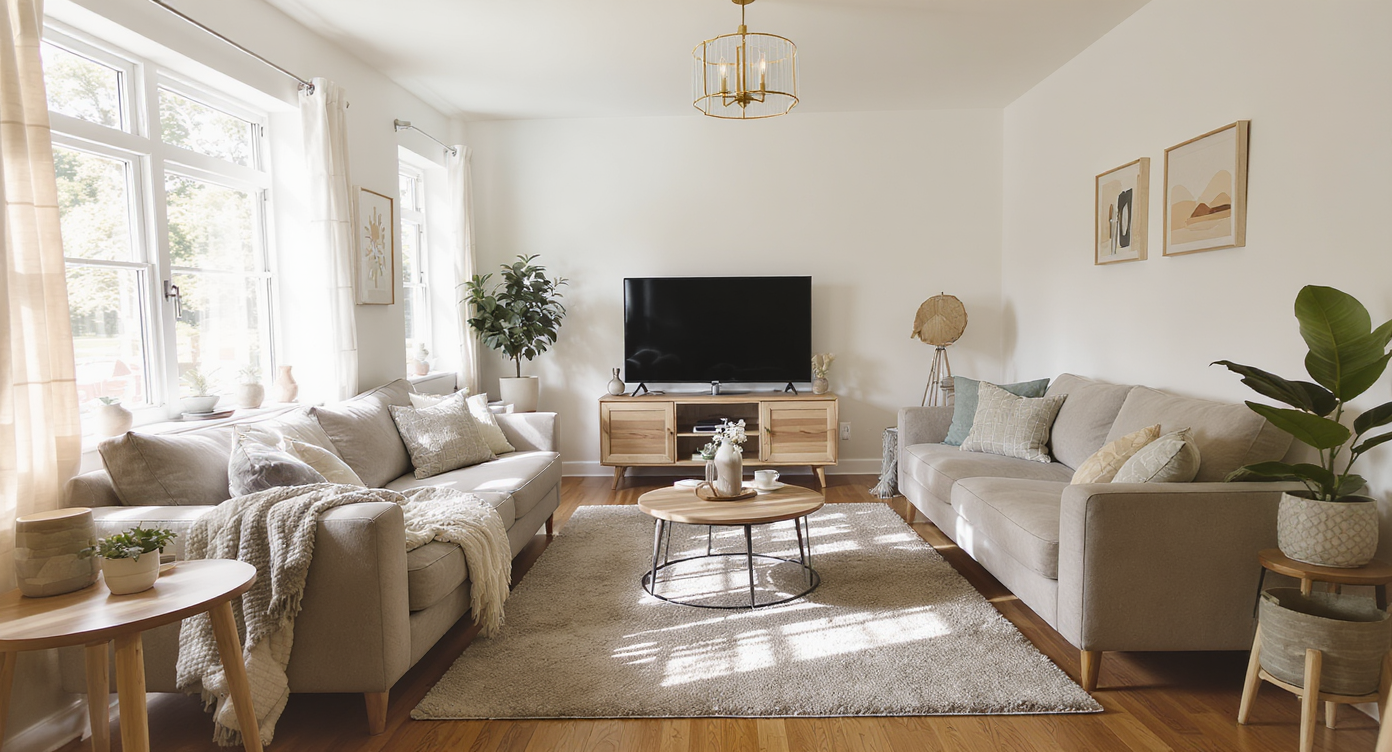






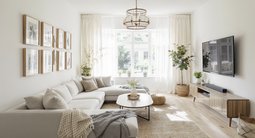





.png)